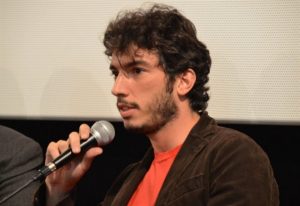“Fortress Europe” is his website.
He defines himself a traveler, writer, blogger and indipendent journalist from Tuscany.
 Gabriele Del Grande, 35 years old, founded his blog in 2006 to tell “Le storie che fanno la storia”, the stories that make history. The website is an Observatory on the victims of the borders, a diary that keeps tracks of people who struggle to build a better life, who escape from a war, who look for a chance to live with dignity.
Gabriele Del Grande, 35 years old, founded his blog in 2006 to tell “Le storie che fanno la storia”, the stories that make history. The website is an Observatory on the victims of the borders, a diary that keeps tracks of people who struggle to build a better life, who escape from a war, who look for a chance to live with dignity.
He analyzes numbers: how many people are moving? How many of them die? How many get arrested because they don’t have a visa? How many stay and how many have to leave?
“Six years of travelling around the Mediterranean along the borders of Europe. In search of the stories that make history. The history that will be studied by our children who will read on the school text books that in 21st century thousands died at sea around Italy and thousands were arrested and deported from our cities. Whilst everybody pretended not to see.” That’s written on the blog’s homepage. He has proofs of what he says.
3 years ago he realized with Antonio Augugliaro e Khaled Soliman Al Nassiry the docu-film “On the bride’s side” based on a real story.
The documentary tells a story that Gabriele has built up and it’s just an example of the way he works. And makes the difference.
Gabriele and his friend decide to help five Palestinians and Syrians, who entered Europe via the Italian island of Lampedusa, complete their journey to Sweden. They’re escaping from the war in Syria, they need to avoid getting themselves arrested as traffickers. In order to do so, they decide to fake a wedding party
With a Palestinian friend dressed up as the bride and other Italian and Syrian friends as wedding ‘guests’, they race across the face of Europe on a four-day journey of 3,000 kilometres.
The trip collects stories of hopes and dreams of the protagonists, but also reveals a special side of Europe that is supportive and encouraging. A Europe that ridicules the laws and restrictions of the so-called ‘Fortress Europe’.
“It all started as a joke” says Gariele in an interview with Al Jazeera,” we were having dinner at our friend Antonio Augugliaro’s house, who is a film director and editor. We were talking about Abdallah’s story and I suddenly came out with it; “You know who the border guards would never stop? A wedding party! The police would never check a bride’s documents!”
Again, what makes Gabriele unique is not only his competence in finding stories and tell them. He knows how to build them up.
Fortress Europe is a privileged point of view on the Mediterranean sea, a window to look at people hunting for dignity.
There are also thirty photographs that Gabriele collected in Tunis. Pictures of young men. Some in colour, some black and white. These pictures were handed to him by their families. They wanted Gabriele to publish them and ask if anyone has seen them in Italy, in the CIEs or in prison or in any other place. Gabriele kept them stored in an envelope inside a notebook with names and dates of birth written in pen, in Arabic.
He published the pictures. On the blog he asks the readers to make an effort by trying to look into these eyes and learn to pronounce their names. And celebrate them. Because they’re probably dead and they’re not only victims. They’re martyrs “fallen in this dirty war of borders. Rebel heroes of a spontaneous civil disobedience movement against unjust border laws and against the criminalization of free movement.”
These faces will be part of the collections in the museum of emigration that will one day open in Lampedusa, like today at Ellis Island in the USA. “Let’s make sure that, from today, these young people have not die in vain.”
Gabriele is a good storyteller who shakes consciences, mine included.

Leave a Reply